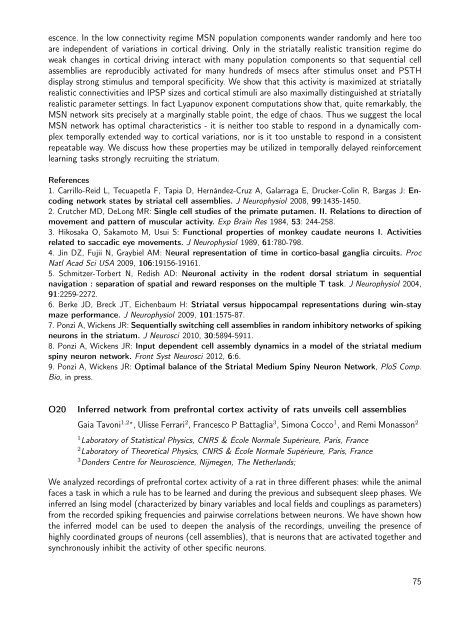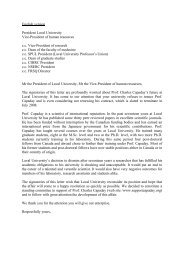Untitled - Laboratory of Neurophysics and Physiology
Untitled - Laboratory of Neurophysics and Physiology
Untitled - Laboratory of Neurophysics and Physiology
Create successful ePaper yourself
Turn your PDF publications into a flip-book with our unique Google optimized e-Paper software.
escence. In the low connectivity regime MSN population components w<strong>and</strong>er r<strong>and</strong>omly <strong>and</strong> here too<br />
are independent <strong>of</strong> variations in cortical driving. Only in the striatally realistic transition regime do<br />
weak changes in cortical driving interact with many population components so that sequential cell<br />
assemblies are reproducibly activated for many hundreds <strong>of</strong> msecs after stimulus onset <strong>and</strong> PSTH<br />
display strong stimulus <strong>and</strong> temporal specificity. We show that this activity is maximized at striatally<br />
realistic connectivities <strong>and</strong> IPSP sizes <strong>and</strong> cortical stimuli are also maximally distinguished at striatally<br />
realistic parameter settings. In fact Lyapunov exponent computations show that, quite remarkably, the<br />
MSN network sits precisely at a marginally stable point, the edge <strong>of</strong> chaos. Thus we suggest the local<br />
MSN network has optimal characteristics - it is neither too stable to respond in a dynamically complex<br />
temporally extended way to cortical variations, nor is it too unstable to respond in a consistent<br />
repeatable way. We discuss how these properties may be utilized in temporally delayed reinforcement<br />
learning tasks strongly recruiting the striatum.<br />
References<br />
1. Carrillo-Reid L, Tecuapetla F, Tapia D, Hernández-Cruz A, Galarraga E, Drucker-Colin R, Bargas J: Encoding<br />
network states by striatal cell assemblies. J Neurophysiol 2008, 99:1435-1450.<br />
2. Crutcher MD, DeLong MR: Single cell studies <strong>of</strong> the primate putamen. II. Relations to direction <strong>of</strong><br />
movement <strong>and</strong> pattern <strong>of</strong> muscular activity. Exp Brain Res 1984, 53: 244-258.<br />
3. Hikosaka O, Sakamoto M, Usui S: Functional properties <strong>of</strong> monkey caudate neurons I. Activities<br />
related to saccadic eye movements. J Neurophysiol 1989, 61:780-798.<br />
4. Jin DZ, Fujii N, Graybiel AM: Neural representation <strong>of</strong> time in cortico-basal ganglia circuits. Proc<br />
Natl Acad Sci USA 2009, 106:19156-19161.<br />
5. Schmitzer-Torbert N, Redish AD: Neuronal activity in the rodent dorsal striatum in sequential<br />
navigation : separation <strong>of</strong> spatial <strong>and</strong> reward responses on the multiple T task. J Neurophysiol 2004,<br />
91:2259-2272.<br />
6. Berke JD, Breck JT, Eichenbaum H: Striatal versus hippocampal representations during win-stay<br />
maze performance. J Neurophysiol 2009, 101:1575-87.<br />
7. Ponzi A, Wickens JR: Sequentially switching cell assemblies in r<strong>and</strong>om inhibitory networks <strong>of</strong> spiking<br />
neurons in the striatum. J Neurosci 2010, 30:5894-5911.<br />
8. Ponzi A, Wickens JR: Input dependent cell assembly dynamics in a model <strong>of</strong> the striatal medium<br />
spiny neuron network. Front Syst Neurosci 2012, 6:6.<br />
9. Ponzi A, Wickens JR: Optimal balance <strong>of</strong> the Striatal Medium Spiny Neuron Network, PloS Comp.<br />
Bio, in press.<br />
O20<br />
Inferred network from prefrontal cortex activity <strong>of</strong> rats unveils cell assemblies<br />
Gaia Tavoni 1,2⋆ , Ulisse Ferrari 2 , Francesco P Battaglia 3 , Simona Cocco 1 , <strong>and</strong> Remi Monasson 2<br />
1 <strong>Laboratory</strong> <strong>of</strong> Statistical Physics, CNRS & École Normale Supérieure, Paris, France<br />
2 <strong>Laboratory</strong> <strong>of</strong> Theoretical Physics, CNRS & École Normale Supérieure, Paris, France<br />
3 Donders Centre for Neuroscience, Nijmegen, The Netherl<strong>and</strong>s;<br />
We analyzed recordings <strong>of</strong> prefrontal cortex activity <strong>of</strong> a rat in three different phases: while the animal<br />
faces a task in which a rule has to be learned <strong>and</strong> during the previous <strong>and</strong> subsequent sleep phases. We<br />
inferred an Ising model (characterized by binary variables <strong>and</strong> local fields <strong>and</strong> couplings as parameters)<br />
from the recorded spiking frequencies <strong>and</strong> pairwise correlations between neurons. We have shown how<br />
the inferred model can be used to deepen the analysis <strong>of</strong> the recordings, unveiling the presence <strong>of</strong><br />
highly coordinated groups <strong>of</strong> neurons (cell assemblies), that is neurons that are activated together <strong>and</strong><br />
synchronously inhibit the activity <strong>of</strong> other specific neurons.<br />
75



